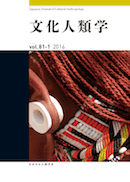77 巻, 1 号
選択された号の論文の28件中1~28を表示しています
- |<
- <
- 1
- >
- >|
-
原稿種別: 表紙
2012 年77 巻1 号 p. Cover1-
発行日: 2012/06/30
公開日: 2017/04/10
PDF形式でダウンロード (15284K) -
原稿種別: 表紙
2012 年77 巻1 号 p. Cover2-
発行日: 2012/06/30
公開日: 2017/04/10
PDF形式でダウンロード (15284K) -
原稿種別: 付録等
2012 年77 巻1 号 p. App1-
発行日: 2012/06/30
公開日: 2017/04/10
PDF形式でダウンロード (73K) -
原稿種別: 本文
2012 年77 巻1 号 p. 1-26
発行日: 2012/06/30
公開日: 2017/04/10
PDF形式でダウンロード (2729K) -
原稿種別: 本文
2012 年77 巻1 号 p. 27-40
発行日: 2012/06/30
公開日: 2017/04/10
PDF形式でダウンロード (1556K) -
原稿種別: 本文
2012 年77 巻1 号 p. 41-59
発行日: 2012/06/30
公開日: 2017/04/10
PDF形式でダウンロード (1950K) -
原稿種別: 本文
2012 年77 巻1 号 p. 60-83
発行日: 2012/06/30
公開日: 2017/04/10
PDF形式でダウンロード (2631K) -
原稿種別: 本文
2012 年77 巻1 号 p. 84-104
発行日: 2012/06/30
公開日: 2017/04/10
PDF形式でダウンロード (2348K) -
原稿種別: 本文
2012 年77 巻1 号 p. 105-127
発行日: 2012/06/30
公開日: 2017/04/10
PDF形式でダウンロード (2389K) -
原稿種別: 本文
2012 年77 巻1 号 p. 128-143
発行日: 2012/06/30
公開日: 2017/04/10
PDF形式でダウンロード (2760K) -
原稿種別: 本文
2012 年77 巻1 号 p. 144-155
発行日: 2012/06/30
公開日: 2017/04/10
PDF形式でダウンロード (1321K) -
原稿種別: 本文
2012 年77 巻1 号 p. 156-169
発行日: 2012/06/30
公開日: 2017/04/10
PDF形式でダウンロード (2506K) -
原稿種別: 本文
2012 年77 巻1 号 p. 170-172
発行日: 2012/06/30
公開日: 2017/04/10
PDF形式でダウンロード (383K) -
原稿種別: 本文
2012 年77 巻1 号 p. 173-176
発行日: 2012/06/30
公開日: 2017/04/10
PDF形式でダウンロード (545K) -
原稿種別: 本文
2012 年77 巻1 号 p. 176-180
発行日: 2012/06/30
公開日: 2017/04/10
PDF形式でダウンロード (699K) -
原稿種別: 本文
2012 年77 巻1 号 p. 180-183
発行日: 2012/06/30
公開日: 2017/04/10
PDF形式でダウンロード (573K) -
原稿種別: 本文
2012 年77 巻1 号 p. 183-186
発行日: 2012/06/30
公開日: 2017/04/10
PDF形式でダウンロード (593K) -
原稿種別: 本文
2012 年77 巻1 号 p. 187-189
発行日: 2012/06/30
公開日: 2017/04/10
PDF形式でダウンロード (450K) -
原稿種別: 本文
2012 年77 巻1 号 p. 189-193
発行日: 2012/06/30
公開日: 2017/04/10
PDF形式でダウンロード (614K) -
原稿種別: 付録等
2012 年77 巻1 号 p. 194-198
発行日: 2012/06/30
公開日: 2017/04/10
PDF形式でダウンロード (382K) -
原稿種別: 付録等
2012 年77 巻1 号 p. 199-201
発行日: 2012/06/30
公開日: 2017/04/10
PDF形式でダウンロード (276K) -
原稿種別: 付録等
2012 年77 巻1 号 p. 201-
発行日: 2012/06/30
公開日: 2017/04/10
PDF形式でダウンロード (75K) -
原稿種別: 付録等
2012 年77 巻1 号 p. 202-
発行日: 2012/06/30
公開日: 2017/04/10
PDF形式でダウンロード (55K) -
原稿種別: 付録等
2012 年77 巻1 号 p. App2-
発行日: 2012/06/30
公開日: 2017/04/10
PDF形式でダウンロード (38K) -
原稿種別: 付録等
2012 年77 巻1 号 p. App3-
発行日: 2012/06/30
公開日: 2017/04/10
PDF形式でダウンロード (38K) -
原稿種別: 付録等
2012 年77 巻1 号 p. App4-
発行日: 2012/06/30
公開日: 2017/04/10
PDF形式でダウンロード (38K) -
原稿種別: 表紙
2012 年77 巻1 号 p. Cover3-
発行日: 2012/06/30
公開日: 2017/04/10
PDF形式でダウンロード (61K) -
原稿種別: 表紙
2012 年77 巻1 号 p. Cover4-
発行日: 2012/06/30
公開日: 2017/04/10
PDF形式でダウンロード (61K)
- |<
- <
- 1
- >
- >|
